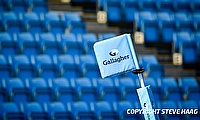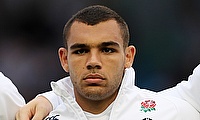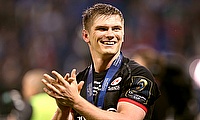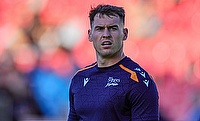TRU's Position Watch - Blindsides
Round 5 has now come and gone in the Aviva Premiership and we have moved onto the blindside flankers in our ‘Position Watch’ series. The workhorses of the back row, blindside flankers are often the beating heart of any team defensively, whilst the demands of the modern game also require them to be willing carriers and adept at the breakdown.
Ability at the lineout is not a requirement depending on the other members of the back row, but it is also viewed very favourably.
Honourable mentions must go to Jamie Gibson, Jackson Wray, Alafoti Fa’osiliva and Sione Kalamafoni who all narrowly missed out, whilst Tom Wood was not considered due to him playing the majority of his club games on the openside.
8. Luke Wallace, Harlequins
A highly energetic flanker, Wallace sneaks into the top eight thanks to his combination of work ethic, breakdown expertise and dynamic ability in the loose. After a breakthrough season in 2011/12, a bright future was predicted for the versatile flanker, who is equally adept in the seven jersey as he is in the six.
Wallace’s meteoric rise lost a little momentum last season, but at just 24 years of age, there is plenty of time left for Wallace to make good on his enormous potential. Despite a lacklustre start to the season from Quins in general, Wallace has performed solidly, but will be eager to make a bigger impact as the season rolls on.
7. Kelly Brown, Saracens
The Scotsman has only made two starts for Saracens so far this season, as well as a third appearance from the bench, but when the pivotal fixtures roll around, there’s little doubt Brown will be the man holding down the blindside flank.
The competition between Brown and Wray for playing time at Saracens, and the resulting rotation, usually pays large dividends for the North Londoners, with the club almost always able to field a high-quality and refreshed blindside flanker in their XV. An oft underrated player at both club and international level, Brown’s lack of appearances compared to many of the players yet to be mentioned are the only reason he is denied a higher place in these rankings.
6. Blair Cowan, London Irish
Although a proficient performer for Cornish Pirates and Worcester Warriors, it was Cowan’s move to London Irish last season that saw him finally earn the recognition his ability deserves. The New Zealand-born back rower, like Wallace, is a hybrid flanker that can do a job on either side of the scrum, whether that job is leading his team in tackles, getting himself over the ball at the breakdown, making the hard yards with ball in hand, or as it is in most matches, all of the above.
Cowan has made a blistering start to the season, including a 20 tackle performance against Newcastle in Round 2, and has been pivotal in helping London Irish to an impressive two wins and three losing bonus points in a tough opening five games to the 2014/15 season.
5. Calum Clark, Northampton Saints
Playing in a back row that features Samu Manoa and Wood, Clark unsurprisingly misses out on much of the praise that is lavished on his more high-profile colleagues. Every bit as vital to Northampton’s gameplan of set-piece domination and high intensity defence as Wood or Manoa, Clark is really emerging from their shadows this season.
With Wood suffering from a back injury and Manoa, Newcastle game aside, making a fairly quiet start to the season, Clark has been the standout performer in the Northampton back row. The former Leeds (now Yorkshire Carnegie) man has started all five games for the Saints so far this season, leading the club in tackles and is second only to the high-flying duo of Courtney Lawes and Christian Day in lineout takes. On form alone, Clark must be in contention for a spot in the upcoming EPS squad.
4. Dave Ewers, Exeter Chiefs
The arrival of Thomas Waldrom at Exeter has seen Ewers move from his favoured position at the base of the scrum to the blindside. Since then, worries that Waldrom might eat into Ewers’ playing time have been quashed, as the Zimbabwean-born back row has been a revelation in his new position.
Ewers has brought his trademark, powerful carrying to the blindside, as well as already significantly developing his defensive game, much in the same vein as Billy Vunipola did at Saracens last season. His two tries seem scant reward for his performances with ball in hand so far this season, but needless to say, it looks as if many more are coming.
3. Daniel Braid, Sale Sharks
Injuries have so far robbed Braid the opportunity of making any sort of tangible impact on the 2014/15 Aviva Premiership season, but that doesn’t prevent the New Zealander from featuring highly on this list, such were the calibre of his performances last season.
Braid became a fan favourite in Auckland due to his all-round skillset and committed performances and has shown that and then some since his arrival in Sale in 2013. His upcoming return from injury, alongside a solid home win against Wasps this weekend, could be just the tonic needed for the sputtering Sharks.
2. Ashley Johnson, Wasps
Johnson arrived from the Cheetahs as an out-and-out number eight, but as with the previously mentioned Ewers and Vunipola, a move to the blindside beckoned for the South African. As with those two fellow back rowers, there is no doubt that Johnson’s defensive game has improved as a result of this transition.
Johnson’s stellar performances in 2013/14 were key to helping Wasps return to Europe’s premiere club competition, whilst his form in the early part of the 2014/15 season has been nothing short of spectacular. The flanker has been a force defensively, whilst his work in the loose, particularly his decision-making and distribution, has enabled the likes of Christian Wade and Tom Varndell outside of him to shine.
1. Tom Croft, Leicester Tigers
Injuries are a cruel blight on any sport, but no sportsman or woman has seemingly suffered as badly as Croft. On his day, arguably the most talented player at his position in world rugby, but avoiding serious and nagging injuries both have proven to be a bridge too far for Croft so far in his career.
A fearsome physical specimen, Croft is the prototypical modern back row forward. A high-flyer at the lineout, Croft also possesses breakneck speed and the soft hands required to make the most of the situations his physical attributes allow him to get into. Naysayers will attack his ability at the breakdown, but if you’re lucky enough to have a player like Croft in your team, you build around him and mould your gameplan to his strengths, such is his talent.
His injury-enforced exclusions from the England team have been mitigated by good depth at his position, but the loss of his talent is certainly comparable to Jonny Wilkinson’s after the 2003 Rugby World Cup.








